Where you see this button
Spider Collector's Journal (22nd page: 2012) Copyright © 2012 by Rod Crawford
Here's the 22nd page of narratives of fun (and not so fun)
trips to collect spiders for research at the Burke
Museum, often accompanied by capable field volunteers Joy Liu and Matisse Lorance. Most also appeared in Scarabogram, newsletter of "Scarabs:
The Bug Society." Dates of field trips head each paragraph. Maps showing
the location of sites within Washington state follow the grid system outlined
in the Washington
Spider Checklist. RETURN
TO INDEX
Where you see this button ![]() in a
field trip account, click it to get a page of collecting site photos!
in a
field trip account, click it to get a page of collecting site photos!
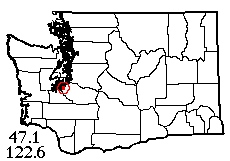 |
![]() 28 I 2012: The first field trip of 2012 came unusually early thanks to a fortuitous weather window. We assumed all the snow of 10 days before was melted from the lowlands, certainly from sites close to sea level. So Joy Liu (new field volunteer) and I headed for the Sequalitchew Creek Trail, a natural area on lands of the city of Dupont (starting next to the Dupont City Hall), a moderate 50-mile drive for us. On our way south, several brief rain spatters hit the windshield, making us fear the whole thing would be a washout, but on reaching Dupont conditions were cloudy but dry and remained so. Next problem, the trailhead sported a very large "closed" sign, of which the trail website gave me no warning. I thought to inquire at the adjacent police station but it was closed. We figured no one would bother us if we collected in the first quarter mile, especially since several dog-walkers, some with kids, were using the trail with impunity. One told me that the closure was due to downed trees farther down the ravine. Anyway, if we’d gone farther the spiders would have been under snow – yes, on a trail leading down to Puget Sound!
28 I 2012: The first field trip of 2012 came unusually early thanks to a fortuitous weather window. We assumed all the snow of 10 days before was melted from the lowlands, certainly from sites close to sea level. So Joy Liu (new field volunteer) and I headed for the Sequalitchew Creek Trail, a natural area on lands of the city of Dupont (starting next to the Dupont City Hall), a moderate 50-mile drive for us. On our way south, several brief rain spatters hit the windshield, making us fear the whole thing would be a washout, but on reaching Dupont conditions were cloudy but dry and remained so. Next problem, the trailhead sported a very large "closed" sign, of which the trail website gave me no warning. I thought to inquire at the adjacent police station but it was closed. We figured no one would bother us if we collected in the first quarter mile, especially since several dog-walkers, some with kids, were using the trail with impunity. One told me that the closure was due to downed trees farther down the ravine. Anyway, if we’d gone farther the spiders would have been under snow – yes, on a trail leading down to Puget Sound!
Joy started by beating Douglas-fir foliage, at which her skill continues to improve. This time she got 11 species, several of them being grassland types: the general habitat, where not altered, was oak-grassland savanna outside the ravine proper. I sifted oak litter and found quite a diverse fauna, though somewhat sparse, with a further 11 spider species and an unfamiliar harvestman of the genus Oligolophus. Joy beat Scots broom from which she got the rare Linyphantes eureka, among others. We both swept the very limited amount of understory foliage, and I got a few more species from grass sweeping and moss sifting. Finally we tried to gather some house spiders from the nearby civic center buildings, adding two for a total day’s catch of 36 – very good for January. We’d just finished checking the walls of the seemingly deserted fire station when the firemen returned from a fire! Fortunately they weren’t upset, just interested.
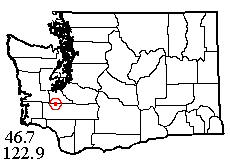 |
![]() 5 II 2012: Soon after our first winter trip, an even better weather window opened: the beautiful weather spell we always have in February came unusually early. Since we’d had such good luck last time in the oak belt, I picked another grassland destination farther south (this time, as it turned out, without oaks on site). Within the Amtrak railroad right-of-way, it’s one of the sites I scouted during a train trip in 2008. The site is at the north end of what the topo map calls Waunch Prairie (now all farmed). We found the turnoff without trouble and drove right up to the tracks, which we walked along to a grove of big mossy alder trees. There was nothing there for Joy to do, so I sent her back toward the road to beat vegetation while I sifted tree moss (11 species) and alder litter (added only 4). Right across the tracks was the Skookumchuck River, where I tried to get some spiders from sun-warmed grass/alder litter at the top of the ravine. One spider! Now the tall field grass was dry enough to sweep, only the stuff was so matted it was more like beating. Whatever, I got 50-60 microspider specimens – possibly ballooning in February? - and a few macros as well. Alas, most of the micros were juveniles, probably Dismodicus sp., but 9 species were identifiable. During this gorgeous day (even shirtsleeve weather for a while), a number of trains went by, but I met only one human afoot, a steelhead fisherman. Meanwhile, Joy had beaten 17 species from conifer foliage, including a planted Araucaria in someone’s yard, plus a sample from bare snowberry bushes, and spotted the butchered remains of 3 deer. While I finished sifting some Oregon ash litter (added only Oedothorax), I had her look under objects in an accumulation of tires and other junk beside the tracks, where she found the uncommon Cicurina tersa. It was now too late to go elsewhere, so we headed for home with 35-36 species.
5 II 2012: Soon after our first winter trip, an even better weather window opened: the beautiful weather spell we always have in February came unusually early. Since we’d had such good luck last time in the oak belt, I picked another grassland destination farther south (this time, as it turned out, without oaks on site). Within the Amtrak railroad right-of-way, it’s one of the sites I scouted during a train trip in 2008. The site is at the north end of what the topo map calls Waunch Prairie (now all farmed). We found the turnoff without trouble and drove right up to the tracks, which we walked along to a grove of big mossy alder trees. There was nothing there for Joy to do, so I sent her back toward the road to beat vegetation while I sifted tree moss (11 species) and alder litter (added only 4). Right across the tracks was the Skookumchuck River, where I tried to get some spiders from sun-warmed grass/alder litter at the top of the ravine. One spider! Now the tall field grass was dry enough to sweep, only the stuff was so matted it was more like beating. Whatever, I got 50-60 microspider specimens – possibly ballooning in February? - and a few macros as well. Alas, most of the micros were juveniles, probably Dismodicus sp., but 9 species were identifiable. During this gorgeous day (even shirtsleeve weather for a while), a number of trains went by, but I met only one human afoot, a steelhead fisherman. Meanwhile, Joy had beaten 17 species from conifer foliage, including a planted Araucaria in someone’s yard, plus a sample from bare snowberry bushes, and spotted the butchered remains of 3 deer. While I finished sifting some Oregon ash litter (added only Oedothorax), I had her look under objects in an accumulation of tires and other junk beside the tracks, where she found the uncommon Cicurina tersa. It was now too late to go elsewhere, so we headed for home with 35-36 species.
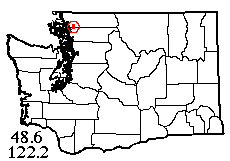 |
![]() 15 IV 2012: March having been a washout, we finally got some decent spring weather in mid-April. My planned destination was McGlinn Island, which is reached via a causeway across the tidal flats from La Conner, and is entirely public open space according to the Skagit County website. But a business located along the causeway had put up a gate, closed on weekends, with a big No Trespassing sign. A local boat captain we talked to was surprised at the sign, and offered to take us down by water but his boat wasn’t handy at the moment. Oh well, these things happen. Fortunately I had a Plan B.
15 IV 2012: March having been a washout, we finally got some decent spring weather in mid-April. My planned destination was McGlinn Island, which is reached via a causeway across the tidal flats from La Conner, and is entirely public open space according to the Skagit County website. But a business located along the causeway had put up a gate, closed on weekends, with a big No Trespassing sign. A local boat captain we talked to was surprised at the sign, and offered to take us down by water but his boat wasn’t handy at the moment. Oh well, these things happen. Fortunately I had a Plan B.
A little farther north along I-5 we followed a nice set of directions I’d found online, along a succession of country roads, to a gate (usually open) on the south flank of Anderson Mountain, north side of the Skagit Valley and largely public land. Alas, the gate was closed today, a big surprise to other visitors as well, but in this case there was no problem with our hiking up the road. The day was getting more and more pleasant as Joy and I reached the edge of the area I wanted to sample. We left the logging road, immediately stumbled onto a parallel hiking trail, and followed that to a beautiful sylvan dell in mature seral forest along a tributary of Parson Creek. I showed Joy how to sample understory foliage and she soon wandered out of sight, leaving her jacket behind in the balmy spring air. I sifted litter (mostly sparse but with some pockets of seemingly good stuff) and moss (also rather sparse), and apparently got a reasonable number of species. I tapped a few more from chunks of the wood of old, giant stumps. Joy came back with 2 vials full of understory spiders, and we returned to the road in search of more habitats. About a half mile further we finally found some reachable Douglas-fir foliage, and there was some roadside grass to sweep, each producing several species. It was now almost 5 PM and no further habitats were in sight, so we strolled back down the mountain and headed home. Next day as I sorted the sample, the awful truth dawned: the nice-looking (though not remarkable) habitats had exceptionally low spider diversity and we got only 18 species for the day! That’s amazingly bad for a spring trip, but at least it was a pleasant day in sylvan surroundings. This sample would have to be supplemented at another nearby site, I hoped a more productive one! (Not to keep you in suspense, we succeeded in late May).
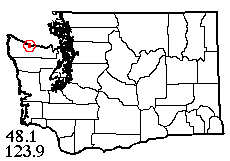 |
![]() 7 V 2012: After 3 weeks of mostly bad weather, with no one available on the few good days, Joy and I set off on a fine spring morning for the Olympic Peninsula. The main goal was Twin Rivers, about 25 miles west of Port Angeles, where I had a few old records from 1984 to supplement. On the way, Joy enjoyed her ferry ride (only the second time for her), plus local color in Port Angeles and Joyce. West Twin River reaches the Straits at a small, unpublicized tract of public beach, so Joy got her wish of some beach-collecting before she leaves Washington. It’s a nice beach, part sand but mostly gravel, not trashed at all, but with only a narrow (and not very diverse) beach meadow zone, reached by an unmarked steep trail. The orange harvestman Sclerobunus nondimorphicus was very common here, under driftwood and in litter, but the driftwood produced only 2 spider species. As the day warmed, big Pardosa lowriei became active, but the expected jumping spiders never appeared in the somewhat hazy daylight. I swept 9 species from the beach meadow, including Porrhomma convexum (least common species taken), and sifted 9 spider and 3 harvestman species from grass/alder litter near the forest edge.
7 V 2012: After 3 weeks of mostly bad weather, with no one available on the few good days, Joy and I set off on a fine spring morning for the Olympic Peninsula. The main goal was Twin Rivers, about 25 miles west of Port Angeles, where I had a few old records from 1984 to supplement. On the way, Joy enjoyed her ferry ride (only the second time for her), plus local color in Port Angeles and Joyce. West Twin River reaches the Straits at a small, unpublicized tract of public beach, so Joy got her wish of some beach-collecting before she leaves Washington. It’s a nice beach, part sand but mostly gravel, not trashed at all, but with only a narrow (and not very diverse) beach meadow zone, reached by an unmarked steep trail. The orange harvestman Sclerobunus nondimorphicus was very common here, under driftwood and in litter, but the driftwood produced only 2 spider species. As the day warmed, big Pardosa lowriei became active, but the expected jumping spiders never appeared in the somewhat hazy daylight. I swept 9 species from the beach meadow, including Porrhomma convexum (least common species taken), and sifted 9 spider and 3 harvestman species from grass/alder litter near the forest edge.
Feeling that the beach sample, though interesting, was not as diverse as it might have been, we stopped at a roadside field about 3 miles up the highway to add upland spiders in the same grid-area. Here, Pardosa vancouveri and P. moesta were abundantly active in the grass; Joy beat 10 species from conifer foliage, I got several more each from grass, vine-maple litter, and moss, and we ended with 34 species from Twin Rivers on this day alone.
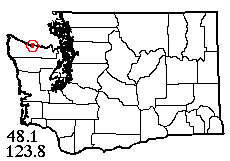 |
![]() Having some hours of daylight left, I decided to try for a quick sample around the state campground on the Lyre River, east of Twin Rivers and with considerably more water flowing. This campground is a really lovely spot, with river, flowers, moss, and diverse flora, and not a soul there but us! The one drawback was that private land prevented any beach access here. However, in 3 hours Joy got 11 species from conifer foliage (including Linyphantes orcinus and Theridion saanichum), I swept a few from riparian understory and sifted 9 from moss and 7 from litter; the camp outhouse was a rich source of mature Callobius pictus, Calymmaria emertoni and Pimoa altioculata. We left here on time with a new sample of 24-25 species.
Having some hours of daylight left, I decided to try for a quick sample around the state campground on the Lyre River, east of Twin Rivers and with considerably more water flowing. This campground is a really lovely spot, with river, flowers, moss, and diverse flora, and not a soul there but us! The one drawback was that private land prevented any beach access here. However, in 3 hours Joy got 11 species from conifer foliage (including Linyphantes orcinus and Theridion saanichum), I swept a few from riparian understory and sifted 9 from moss and 7 from litter; the camp outhouse was a rich source of mature Callobius pictus, Calymmaria emertoni and Pimoa altioculata. We left here on time with a new sample of 24-25 species.
Up to now, all had gone smoothly. We were almost back to the Hood Canal Bridge, when, horrors! we discovered it had just been closed for repairs! So we sat on the highway for over an hour until the construction crew decided to let a few cars (including us) over – just a little bit too late to catch the last ferry from Kingston! I thought we could make the next-to-last Bainbridge ferry, and would have if we hadn’t been briefly lost in Poulsbo; as it was, we waited at the Winslow ferry dock for another hour and finally got home about 1:30 AM!
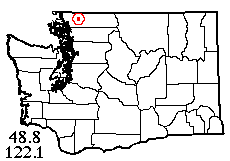 |
![]() 26 V 2012: Today's plan was to complete the partial sample from last month's trip to Anderson Mountain, then collect at Deming Homestead Eagle Park on the South Fork Nooksack River, near where I had taken 7 rather interesting species back in 1984. First, we hit Highway 9 north of Sedro Woolley and headed north. Oops, road closed, must backtrack and drive in by way of Lake Whatcom. In spite of the delay we reached Mirror Lake (at the NE base of Anderson Mountain) in good time, and found a large meadow at the lake's upstream end accessible as I'd hoped. Soon after we'd passed the invading blackberry at the edge, it developed that the meadow was really a marsh – but it was possible with care to hop from tussock to tussock and keep sweeping the grass. Joy was watching me when I seemed to disappear! A tussock gave way, dropping me into a watery hole. At least it was a nice warm day to have wet feet. The spiders out in the marsh weren't too diverse, so I headed for a more floristically diverse roadside verge habitat on the county road right-of-way at the edge of private land uphill. Suddenly a female resident (invisible to me behind a fringe of foliage, but very audible) asked what I was looking for. "Spiders!" "Oh, take all of them, please!" We didn't manage that feat but we did boost the former 18-species sample up to 27 in about an hour.
26 V 2012: Today's plan was to complete the partial sample from last month's trip to Anderson Mountain, then collect at Deming Homestead Eagle Park on the South Fork Nooksack River, near where I had taken 7 rather interesting species back in 1984. First, we hit Highway 9 north of Sedro Woolley and headed north. Oops, road closed, must backtrack and drive in by way of Lake Whatcom. In spite of the delay we reached Mirror Lake (at the NE base of Anderson Mountain) in good time, and found a large meadow at the lake's upstream end accessible as I'd hoped. Soon after we'd passed the invading blackberry at the edge, it developed that the meadow was really a marsh – but it was possible with care to hop from tussock to tussock and keep sweeping the grass. Joy was watching me when I seemed to disappear! A tussock gave way, dropping me into a watery hole. At least it was a nice warm day to have wet feet. The spiders out in the marsh weren't too diverse, so I headed for a more floristically diverse roadside verge habitat on the county road right-of-way at the edge of private land uphill. Suddenly a female resident (invisible to me behind a fringe of foliage, but very audible) asked what I was looking for. "Spiders!" "Oh, take all of them, please!" We didn't manage that feat but we did boost the former 18-species sample up to 27 in about an hour.
Deming Homestead Park, recently established by Whatcom County, is dedicated to fall viewing of bald eagles, but is also a nice example of former farmland going back to nature, with diverse trees (cottonwood dominant but varied others including Sitka spruce) and grassy fields from glade-sized to 5-acre. There's also extensive flood-scoured river bar habitat, inaccessible today because of water-filled oxbow channels. The wooden sign greeting us also provided a nice male Coriarachne brunneipes. Joy spent some time beating several species of conifer foliage while I swept spiders in the fields, chiefly from grass and buttercups. As we might have expected, introduced spider species were numerous; Entelecara acuminata was common in both the grass and tree foliage; but native spiders were by no means lacking. At the far side of the biggest field, I found good litter in a cottonwood-maple grove on the bank of a big side channel of the river, and added some understory species also, for 31 total species from the park.
Hoping for different habitat, we stopped at tiny Case Nooksack Cemetery on our way out, parking in a verdant driveway-like plot alongside. The cemetery itself is rather well groomed despite its age, but provided two more spider species, Cyclosa conica from a web at the edge and Pardosa vancouveri active among the tombstones. Other habitats were fenced off. Leaving, Joy made the mistake of driving forward to turn around. But just ahead of us, the grassy surface concealed soft mud, and the university car was not a good mudder! We spun wheels back and forth for the next 15-20 minutes, throwing up mud globs all over the formerly spotless white car, before a combination of pushing and backing up got us out. We took revenge on a place that had gouged us on the price of gas earlier by using their facilities to clean the car up a bit before returning it…
 |
![]() 2 VI 2012: For some years, I’ve been hoping to supplement an old 12-species sample (mostly donated specimens) from the east side of the Columbia River above East Wenatchee. A longish drive, but Joy was up for it, and on this date other sites were forecast as too wet or too windy. On the way, we stopped for a pair of the good-for-all-day burgers at E-Z’s Burger Deluxe in Wenatchee. My first planned site proved to be in a restricted area (too close to a dam, I guess) but the second, a roadside viewpoint with some riverside habitat attached, worked out OK, though it’s about the only place in eastern Washington where I’ve seen a substantial stand of the wretched Himalayan blackberry. We were lucky to be on the east bank of the river; a large brush fire was in progress on the west bank! There were riparian meadows with lush wild rose bushes that perfumed the air, and my first sweep filled the net with jumping spiders, mostly Sassacus vitis; that’s the kind of sweep I like! Only a few other species were amenable to sweeping (and there was nothing different on the rose bushes), so I tried some litter sifting: not much there but I did get Zanomys kaiba. Meanwhile Joy had found a more open tract on the other side of the turnout that had a section of sagebrush habitat and a big stand of yellow-blooming Sisymbrium. Here we got several other species, most interesting being Mallos pallidus from the sagebrush. Not a really diverse fauna at this site with lots of non-native plants and trees, but it did boost the old sample up to 24 species.
2 VI 2012: For some years, I’ve been hoping to supplement an old 12-species sample (mostly donated specimens) from the east side of the Columbia River above East Wenatchee. A longish drive, but Joy was up for it, and on this date other sites were forecast as too wet or too windy. On the way, we stopped for a pair of the good-for-all-day burgers at E-Z’s Burger Deluxe in Wenatchee. My first planned site proved to be in a restricted area (too close to a dam, I guess) but the second, a roadside viewpoint with some riverside habitat attached, worked out OK, though it’s about the only place in eastern Washington where I’ve seen a substantial stand of the wretched Himalayan blackberry. We were lucky to be on the east bank of the river; a large brush fire was in progress on the west bank! There were riparian meadows with lush wild rose bushes that perfumed the air, and my first sweep filled the net with jumping spiders, mostly Sassacus vitis; that’s the kind of sweep I like! Only a few other species were amenable to sweeping (and there was nothing different on the rose bushes), so I tried some litter sifting: not much there but I did get Zanomys kaiba. Meanwhile Joy had found a more open tract on the other side of the turnout that had a section of sagebrush habitat and a big stand of yellow-blooming Sisymbrium. Here we got several other species, most interesting being Mallos pallidus from the sagebrush. Not a really diverse fauna at this site with lots of non-native plants and trees, but it did boost the old sample up to 24 species.
![]() For the last part of the day I wanted to go up Derby Canyon near Peshastin, hoping to add at least 20 species to the solitary wolf spider taken nearby by a lepidopterist. Though right at the edge of the national forest (with private homes and ranches across the fence), our site had a largely natural flora of ponderosa-Pseudotsuga forest with glades and maple stands, with a variety of flowering herbs on the more open pine slopes. We’d been out of our car under 5 minutes when a big, gregarious golden retriever from the nearest home joined us, and hung out with Joy and me alternately through the rest of the day, heading for home the minute we got back into the car! Sweeping a small grass field and more extensive roadside verge produced 7 species including a Theridion with totally unfamiliar coloration. I added 2 species from litter and tried beating 45 pine cones in Laurel Ramseyer’s technique, getting a few spiders but none different. Joy had got several interesting species from conifer foliage and was getting a bit anxious to head for home, so I quickly headed up a nice trail into dense forest (accompanied by the dog), sweeping understory as I went, for some interesting additions including the very rare Dipoena #1, while Joy found two good species under rocks. We just managed 21-23 species to complete the sample started so long ago with that one wolf spider.
For the last part of the day I wanted to go up Derby Canyon near Peshastin, hoping to add at least 20 species to the solitary wolf spider taken nearby by a lepidopterist. Though right at the edge of the national forest (with private homes and ranches across the fence), our site had a largely natural flora of ponderosa-Pseudotsuga forest with glades and maple stands, with a variety of flowering herbs on the more open pine slopes. We’d been out of our car under 5 minutes when a big, gregarious golden retriever from the nearest home joined us, and hung out with Joy and me alternately through the rest of the day, heading for home the minute we got back into the car! Sweeping a small grass field and more extensive roadside verge produced 7 species including a Theridion with totally unfamiliar coloration. I added 2 species from litter and tried beating 45 pine cones in Laurel Ramseyer’s technique, getting a few spiders but none different. Joy had got several interesting species from conifer foliage and was getting a bit anxious to head for home, so I quickly headed up a nice trail into dense forest (accompanied by the dog), sweeping understory as I went, for some interesting additions including the very rare Dipoena #1, while Joy found two good species under rocks. We just managed 21-23 species to complete the sample started so long ago with that one wolf spider.
 |
![]() 20 VI 2012: Joy Liu, my invaluable assistant, has now left Washington, alas! One field trip had been planned with the Austin family car, and after some delays, finally took place on the day of the summer solstice (identified by my wall calendar as Errol Flynn’s birthday). Three of us (Fred and Jerry Austin and I) headed across Stevens Pass and up the Lake Wenatchee road to the Chiwawa River, in an area where I had one former record from a last-year’s pine-cone sample. First, we stopped where a side road crosses Chikamin Creek; aerial photos had identified a potential wetland downstream, and sure enough, it was visible from the road. Jerry went down one side of the creek, reaching the grassier areas of the wet meadow, while I had more shrubby tracts on the other side. Between us we got a nice sweep sample of 10 spider species, better than I realized at the time, though not including any real rarities. On the way back to the car I stopped for an hour in a small stand of bigger trees with good conifer litter. Litter spiders proved a bit sparse, but the 4 species taken included the very rare Scotinotylus #4; meanwhile Jerry hunted for me far and wide, not realizing I was within easy hail of the car but invisible behind a steep bank. A few more species from conifer foliage brought our total for this site to 17 species.
20 VI 2012: Joy Liu, my invaluable assistant, has now left Washington, alas! One field trip had been planned with the Austin family car, and after some delays, finally took place on the day of the summer solstice (identified by my wall calendar as Errol Flynn’s birthday). Three of us (Fred and Jerry Austin and I) headed across Stevens Pass and up the Lake Wenatchee road to the Chiwawa River, in an area where I had one former record from a last-year’s pine-cone sample. First, we stopped where a side road crosses Chikamin Creek; aerial photos had identified a potential wetland downstream, and sure enough, it was visible from the road. Jerry went down one side of the creek, reaching the grassier areas of the wet meadow, while I had more shrubby tracts on the other side. Between us we got a nice sweep sample of 10 spider species, better than I realized at the time, though not including any real rarities. On the way back to the car I stopped for an hour in a small stand of bigger trees with good conifer litter. Litter spiders proved a bit sparse, but the 4 species taken included the very rare Scotinotylus #4; meanwhile Jerry hunted for me far and wide, not realizing I was within easy hail of the car but invisible behind a steep bank. A few more species from conifer foliage brought our total for this site to 17 species.
We drove about 4 miles on up the side road to a trailhead on the crest of Minnow Ridge, about 1000’ higher than the creek site and in a mature forest mostly of true fir, with small lodgepole pines and abundant Vaccinium in the understory. Conifer beating here produced a mostly different fauna, including specimens of what appeared to be Theridion lawrencei with dramatically different color patterns, as well as species of Lepthyphantes and Philodromus (the latter also found by Jerry on roadside alder) that I don’t recognize at first glance. There were a fair number of species under bark as well. When we left this site we had 25 species.
But there was still one more habitat I wanted to check out in the grid-area, a meadow in the floodplain of the Chiwawa River. We found it to be a nice rolling grassy expanse with scattered young pines, altered by human activity but still attractive and productive. This was the only site of the day where we found wolf spiders (all juvenile Tarentula, unfortunately). The grass-sweeping and tree-beating added a few more species not at the other sites, including an unusual Pityohyphantes, and I got Cicurina #2 under a large chunk of burnt wood. With 29 species in hand (making 30 with the one prior record), we called it a day and left the numerous mosquitos (and abundant other wildlife) in possession. We would have stopped for a burger but Zeke’s was closed long before we reached Gold Bar; oh well, a good field day anyway.
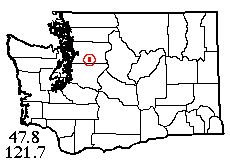 |
![]() 27 VI 2012: Today was the one predicted summery day in this first week of summer, but no vehicle was available, so I used a back-up plan and took buses first to Everett, then out to the town of Sultan on U.S. 2. Walking out to the town cemetery (site of a recent macabre incident), I found a quite-nice grassy field on adjacent city land, formerly the edge of a landfill. My first sweep netted five spider species! In all I swept 8 spider and 1 harvestman species, plus Pardosa moesta active in the grass (but hard to chase on such a warm day) and Salticus scenicus on a wooden bench. The usual blackberry thicket bordering the field had almost swallowed up a small sheet-metal shed, from which I took 2 house spiders. The adjacent forest tract, also city land and another of my planned habitats, was largely barred to me by more blackberry; but one section that was swallowed by ivy instead, gave me access to a slope habitat where I got 1 species from litter and a welcome 6 from some of the last surviving native understory foliage, plus more harvestmen. Finally, across the road on a tract belonging to the county fire district, was an interesting stony habitat with firs, lodgepole pine and even a madrona tree; here I got 9 species from conifer foliage. Though the habitats were degraded and 12 of the 22 species taken were non-native, it was a worthwhile data point obtained at little expense and less than a full days's time. But I tell you, it ain't easy for a pedestrian to cross the Stevens Pass highway to catch a bus home; those drivers don't want to stop!
27 VI 2012: Today was the one predicted summery day in this first week of summer, but no vehicle was available, so I used a back-up plan and took buses first to Everett, then out to the town of Sultan on U.S. 2. Walking out to the town cemetery (site of a recent macabre incident), I found a quite-nice grassy field on adjacent city land, formerly the edge of a landfill. My first sweep netted five spider species! In all I swept 8 spider and 1 harvestman species, plus Pardosa moesta active in the grass (but hard to chase on such a warm day) and Salticus scenicus on a wooden bench. The usual blackberry thicket bordering the field had almost swallowed up a small sheet-metal shed, from which I took 2 house spiders. The adjacent forest tract, also city land and another of my planned habitats, was largely barred to me by more blackberry; but one section that was swallowed by ivy instead, gave me access to a slope habitat where I got 1 species from litter and a welcome 6 from some of the last surviving native understory foliage, plus more harvestmen. Finally, across the road on a tract belonging to the county fire district, was an interesting stony habitat with firs, lodgepole pine and even a madrona tree; here I got 9 species from conifer foliage. Though the habitats were degraded and 12 of the 22 species taken were non-native, it was a worthwhile data point obtained at little expense and less than a full days's time. But I tell you, it ain't easy for a pedestrian to cross the Stevens Pass highway to catch a bus home; those drivers don't want to stop!
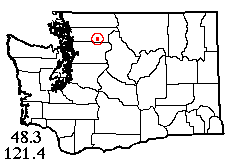 |
![]() 4 VII 2012: I haven't yet replaced Joy (as if that were possible), but had 3 people say they could drive on field trips – on Sundays only. Unable to work on Independence Day due to campus closure, I thought maybe this would qualify as a Sunday and tried to contact the applicants. One, Rachel Webber, came through, and we spent the holiday happily collecting. Our first site was a bridge and boat launch near Darrington where in a half hour we added 5 to a previous 19-species sample. One was the day's best species, a Tutelina similis that Rachel swept from roadside grass in a clear case of beginner's luck. Then we headed up the Suiattle River Road (due to be closed in 2 days for long-needed repairs) to take a little-used side road up Grade Creek and into the mountains (passing, on the way, a group of folks shooting at trees to commemorate the holiday – fireworks being banned in the forest).
4 VII 2012: I haven't yet replaced Joy (as if that were possible), but had 3 people say they could drive on field trips – on Sundays only. Unable to work on Independence Day due to campus closure, I thought maybe this would qualify as a Sunday and tried to contact the applicants. One, Rachel Webber, came through, and we spent the holiday happily collecting. Our first site was a bridge and boat launch near Darrington where in a half hour we added 5 to a previous 19-species sample. One was the day's best species, a Tutelina similis that Rachel swept from roadside grass in a clear case of beginner's luck. Then we headed up the Suiattle River Road (due to be closed in 2 days for long-needed repairs) to take a little-used side road up Grade Creek and into the mountains (passing, on the way, a group of folks shooting at trees to commemorate the holiday – fireworks being banned in the forest).
Our first mountain collecting site (remote, people-free and deliciously peaceful) was a tiny roadside rock quarry at 3750', a half mile before snow barred further driving. Upslope was young western hemlock; we beat 15 species from the foliage. The rocks produced nothing new but below the road was impressive old growth hemlock, with potentially productive litter. Unfortunately, the ground had been too-well-soaked by the previous day's rainfall; I did sift a few specimens. Back down the road we stopped at a mid-elevation stretch of tall grass and swept 7 species, 4 different from the first site and including uncommon Porrhomma convexum. Finally (after a vain attempt to find a route to Tepee Falls), we tried bigleaf maple forest in the floodplain of the Suiattle River, still in the same grid-area, where litter and moss added 2 species and sweeping 4 more (Rachel's contribution included a nice series of dome-weaving Neriene radiata). In all, 26 species where I had none before, and mosquitos were largely absent until some "stealth" Ochlerotatus appeared right at the end. But I'm still looking for a weekday driver.
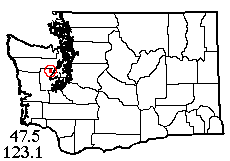 |
![]() 18 VII 2012: My former lab volunteer Matisse Lorance has offered to drive on some field trips, for which I thank her kindly! After ruling out all destinations with a chance of thunderstorms, I was left with the southeastern Olympics for today, where I had an old 4-species sample to supplement. The sky was cloudy as we crossed on the Bremerton ferry, but began to clear as we approached the mountains. When we finally reached our first destination, however, the nameless 3300-foot-elevation ridge crest almost touched the bottom of a persistent cloud bank that continued streaming past most of the day - fortunately without raining.
18 VII 2012: My former lab volunteer Matisse Lorance has offered to drive on some field trips, for which I thank her kindly! After ruling out all destinations with a chance of thunderstorms, I was left with the southeastern Olympics for today, where I had an old 4-species sample to supplement. The sky was cloudy as we crossed on the Bremerton ferry, but began to clear as we approached the mountains. When we finally reached our first destination, however, the nameless 3300-foot-elevation ridge crest almost touched the bottom of a persistent cloud bank that continued streaming past most of the day - fortunately without raining.
We spent a couple of hours beating roadside conifer foliage in young second-growth hemlock and true fir, for a very nice total of 16 spider species. Matisse (who is tender-hearted and brings all her spiders to me for preservation) spotted 2 Pityohyphantes webs in low alders and they turned out to be a very uncommon, undescribed montane species different from most specimens on the conifers. Before leaving the site, we wormed our way through the brush into a magnificent old growth hemlock stand on the adjacent hill. In the cathedral-like peace, I got a decent spider sample from dead wood and a few from conifer litter while an occasional drip of condensation came down from the canopy, invisible in the cloud deck above.
Our second site was a lower-elevation, rocky clearcut we'd passed on the way up, with a diverse tangle of shrubs (both native and invasive), plus grass with dandelions on the edges and roadsides. Here we added 7 species not taken on the high ridge, and I was able to snack on the tastiest red huckleberries I've had in many a year. Pardosa wyuta was active despite the cloud-filtered daylight. Then we spent early evening in another well-kept secret of a nice habitat, a shrubby lowland marsh dominated by Spiraea densiflora but with many herbs plus some sedge, and no water to be seen at this season. Despite the dry ground everything was lush, and we swept 11 species including some likely Neoscona arabesca (I kept one to rear, but it died immature). Willow litter contained little at this season, but I added 2 more species from moss on maples back where the main forest road crosses the east fork of Lilliwaup Creek. In all, we took 33 species making 35 with the old records, and spent a tiring but delightful day in beautiful surroundings. Mosquitos were pleasantly scarce until dusk; the one horse fly ignored me in favor of circling Matisse, probably due to her blue jacket.
![]() 29 VII 2012: The Scarabs field excursion to Wilkeson Creek County Park worked out well: everyone got there easily (about 13 Scarabs and parascarabs attended) and it was a pleasant place to spend an afternoon. Insects and spiders were pretty sparse under the stream cobbles (something we couldn't have known until we tried), but we found a variety of species on vegetation and other habitats. Scarab Schimming got a number of good photos for bugguide.net, including some species new to the guide. Best of all, ripe red huckleberry bushes were found both at the creek and at the nearby cemetery!
29 VII 2012: The Scarabs field excursion to Wilkeson Creek County Park worked out well: everyone got there easily (about 13 Scarabs and parascarabs attended) and it was a pleasant place to spend an afternoon. Insects and spiders were pretty sparse under the stream cobbles (something we couldn't have known until we tried), but we found a variety of species on vegetation and other habitats. Scarab Schimming got a number of good photos for bugguide.net, including some species new to the guide. Best of all, ripe red huckleberry bushes were found both at the creek and at the nearby cemetery!
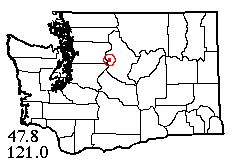 |
![]() 1 VIII 2012: My second collecting trip with volunteer Matisse Lorance also included the rarely-available Jerry Austin. Now being the time for high-elevation collecting, we headed over Stevens Pass to an easily accessible area just on the other side, Rainy Creek Pass and Smithbrook Trail on Nason Ridge, our main sites being around 4600 feet elevation. Arrived at the pass in pleasant weather after a totally problem-free drive, we parked on a side road in a possibly 20-year-old clearcut where fir and hemlock foliage to beat abounded. Matisse beat the trees with such enthusiastic abandon (bringing the netfulls of spiders to me for preservation) that I hardly had time to do any of my own beating! The system worked so well that we ended up with 15 spider species from conifer foliage alone, including one Dictyna species I don't recognize. Jerry's and my ground-scanning produced 3 species of active wolf spiders plus a Zelotes and the beautiful salticid Habronattus jucundus. Jerry also got 5 species under rocks including the uncommon Cybaeopsis macarius. Across the main road, Matisse and I located a trail not on the map, and a small creek starting in a sizable seep meadow. There weren't too many sweepable spiders in the meadow, but the wet ground was covered with microspider webs; unfortunately I didn't manage to tease any of the spiders out from among the grass roots. In an adjacent forest patch, we tapped three species from dead wood; after we'd been wood-tapping for 20 minutes or so, a nearby woodpecker (hitherto silent) got into the act! We finished up the pass area with a visit to a small pond that added one more species.
1 VIII 2012: My second collecting trip with volunteer Matisse Lorance also included the rarely-available Jerry Austin. Now being the time for high-elevation collecting, we headed over Stevens Pass to an easily accessible area just on the other side, Rainy Creek Pass and Smithbrook Trail on Nason Ridge, our main sites being around 4600 feet elevation. Arrived at the pass in pleasant weather after a totally problem-free drive, we parked on a side road in a possibly 20-year-old clearcut where fir and hemlock foliage to beat abounded. Matisse beat the trees with such enthusiastic abandon (bringing the netfulls of spiders to me for preservation) that I hardly had time to do any of my own beating! The system worked so well that we ended up with 15 spider species from conifer foliage alone, including one Dictyna species I don't recognize. Jerry's and my ground-scanning produced 3 species of active wolf spiders plus a Zelotes and the beautiful salticid Habronattus jucundus. Jerry also got 5 species under rocks including the uncommon Cybaeopsis macarius. Across the main road, Matisse and I located a trail not on the map, and a small creek starting in a sizable seep meadow. There weren't too many sweepable spiders in the meadow, but the wet ground was covered with microspider webs; unfortunately I didn't manage to tease any of the spiders out from among the grass roots. In an adjacent forest patch, we tapped three species from dead wood; after we'd been wood-tapping for 20 minutes or so, a nearby woodpecker (hitherto silent) got into the act! We finished up the pass area with a visit to a small pond that added one more species.
Next on the agenda was Smithbrook Trail, which I hoped would lead us into subalpine meadows and old growth forest. This trail was shown on the map, but the course of the actual trail didn't resemble the mapped one in the slightest. However, the numerous switchbacks did bring us to a ridge crest saddle area that had uncut (if not very large) mature timber, small rocky cliffs and a big marsh meadow surrounded by dense huckleberry and herbs among the sparse wetland trees. Response of a fellow-hiker to spider collecting: "Seriously?" Here I got 4 species each from the dead wood and conifer litter, including lots of Frederickus wilburi and a Scotinotylus-like microspider I don't recognize. Sweeping around the fringes of the marsh by all three of us added several more species, and Matisse scanned the cliffs for rock-face webs, finding the uncommon Theridion montanum among others. Having spent the warm sunny day in beautiful (if well-supplied with mosquitos) surroundings, we came away with 35 spider species in all.
 |
![]() 8 VIII 2012: After a late start due to a pet crisis, Matisse and I were on our way to the northeast edge of Mt. Rainier National Park, where I hoped to supplement some old records from inside with new ones from outside the park boundary. The day was overcast in Seattle, partly sunny near Greenwater, but when we reached Eleanor Creek (at the Lake Eleanor trailhead) we were right at the bottom of a misty cloud deck that stayed with us all day. No sunscreen needed, and it didn't rain so we can't complain! First we swept the abundant roadside flowering herbs; the wildflowers are good this year at 4500 feet! Sweeping produced lots of spiders but nothing too rare. Eight species later we switched to turning roadside stones, unusually good for western Washington with 6 spider and 2 harvestman species including Coreorgonal petulcus and Microhexura idahoana. The spiders of conifer foliage were, as usual, nice and diverse and included a very good series of Dictyna peragrata, not mixed with other similar species as it often is. From time to time, hikers would arrive at the trailhead or come back from the lake, some being curious about our nets and others seemingly didn't even notice them. After exhausting the roadside habitats, we started up the trail. The park boundary was soon reached but between the road and the boundary was a short stretch of good forest habitat that got us the day's best spiders. Tapping dead wood fragments got us 8 spider species, of which the very last specimen (Matisse's find) was a new state record, Poeciloneta canionis. Also several of the orange Sclerobunus harvestmen, seemingly different from the common lowland S. nondimorphicus. Sifting conifer litter added 2 more good species, for 30 total at the site.
8 VIII 2012: After a late start due to a pet crisis, Matisse and I were on our way to the northeast edge of Mt. Rainier National Park, where I hoped to supplement some old records from inside with new ones from outside the park boundary. The day was overcast in Seattle, partly sunny near Greenwater, but when we reached Eleanor Creek (at the Lake Eleanor trailhead) we were right at the bottom of a misty cloud deck that stayed with us all day. No sunscreen needed, and it didn't rain so we can't complain! First we swept the abundant roadside flowering herbs; the wildflowers are good this year at 4500 feet! Sweeping produced lots of spiders but nothing too rare. Eight species later we switched to turning roadside stones, unusually good for western Washington with 6 spider and 2 harvestman species including Coreorgonal petulcus and Microhexura idahoana. The spiders of conifer foliage were, as usual, nice and diverse and included a very good series of Dictyna peragrata, not mixed with other similar species as it often is. From time to time, hikers would arrive at the trailhead or come back from the lake, some being curious about our nets and others seemingly didn't even notice them. After exhausting the roadside habitats, we started up the trail. The park boundary was soon reached but between the road and the boundary was a short stretch of good forest habitat that got us the day's best spiders. Tapping dead wood fragments got us 8 spider species, of which the very last specimen (Matisse's find) was a new state record, Poeciloneta canionis. Also several of the orange Sclerobunus harvestmen, seemingly different from the common lowland S. nondimorphicus. Sifting conifer litter added 2 more good species, for 30 total at the site.
Having a bit of cool misty daylight left, we went north and then south again to a logging road along the next ridge crest to the east, also just outside the park boundary. The forest habitat was a bit different here, with a good number of white pines among the true firs and mountain hemlocks; an old clearcut had open glades covered with beargrass. Sweeping added nothing new here, but the conifer foliage added 3 species to the day's total. We tried sampling from white-pine cones using Laurel Ramseyer's technique but after 110 cones we'd found just one juvenile spider! Mosquitos had been common at the creek site, but on the ridge crest they were swarming! We finally called it a day and got back to Seattle about 10 PM.
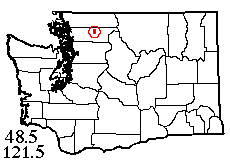 |
![]() 15 VIII 2012: It was another trip with Matisse Lorance and Jerry Austin. The day before, I'd attended a memorial celebration of the late John S. Edwards, entomologist, former boss and coauthor. Today's trip would have pleased John, a confirmed mountaineer: we climbed Sauk Mountain in the North Cascades. Starting from the trailhead at mid-day in very warm clear weather, we reached the summit ridge (5360' elevation) in an hour and a quarter, all being in decent physical condition for a change. The habitat was treeline parkland, mostly meadows of diverse type with rather small tree groups of mountain hemlock and subalpine fir, and a panoramic view of mountains and more mountains. Jerry hunted for rocks to turn over while Matisse and I beat conifer foliage, finding it rather slow going. Eventually I made do with 8 foliage species (2 species that I thought I had were missing from the final count). Sweeping meadow foliage added absolutely nothing new. I set Matisse to beating heather and shrubs, which 2 habitats added one more species each. We couldn't find any dead wood habitat, but I did find some productive conifer needle litter and got 26 microspiders, all but one of them mature. Imagine my disappointment on return to the lab to find that most of them were one species (with one or possibly 2 others represented).
15 VIII 2012: It was another trip with Matisse Lorance and Jerry Austin. The day before, I'd attended a memorial celebration of the late John S. Edwards, entomologist, former boss and coauthor. Today's trip would have pleased John, a confirmed mountaineer: we climbed Sauk Mountain in the North Cascades. Starting from the trailhead at mid-day in very warm clear weather, we reached the summit ridge (5360' elevation) in an hour and a quarter, all being in decent physical condition for a change. The habitat was treeline parkland, mostly meadows of diverse type with rather small tree groups of mountain hemlock and subalpine fir, and a panoramic view of mountains and more mountains. Jerry hunted for rocks to turn over while Matisse and I beat conifer foliage, finding it rather slow going. Eventually I made do with 8 foliage species (2 species that I thought I had were missing from the final count). Sweeping meadow foliage added absolutely nothing new. I set Matisse to beating heather and shrubs, which 2 habitats added one more species each. We couldn't find any dead wood habitat, but I did find some productive conifer needle litter and got 26 microspiders, all but one of them mature. Imagine my disappointment on return to the lab to find that most of them were one species (with one or possibly 2 others represented).
Meanwhile, Jerry had spotted gorgeous Sauk Lake down below the ridge and tried climbing down to it. It was several times farther down than it looked, lower in elevation than the trailhead parking lot — and he didn't have his water bottle! Stopping short of his goal, a refreshing snowfield saved him from incipient heat exhaustion. We'd started to miss him by then, but the mountain was so peaceful, I figured if he'd fallen off a cliff we would have heard him scream… Anyway, he says he must have turned over 250 rocks on the slope to the lake, finding nothing. He and I did get 5 mature spiders under rocks on the summit ridge, each one a different species and including Jerry's prize, large alpine wolf spider Pardosa rainieriana, first finding on a mountain with no permanent ice and snow. It was now time to start down and we needed more spider records. So for the first part of the trail down, I swept herbs and Matisse beat shrubs, each getting a different Dictyna species. On the same stretch, I'd found a nice ground-active jumping spider, Sitticus rainierii, on the way up. End result, at least 20 species but some luck will be required to make a final total of 21. However, we all survived, had a good time, saw wonderful scenery and staved off major sunburn and fly bites.
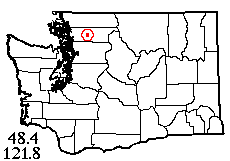 |
![]() 22 VIII 2012: Despite our sparse sample from Sauk Mountain, I wanted to try one more summer subalpine trip. I chose Gee Point
(northeastern Cultus Mountains, south of the Skagit River) because a variety of habitats could be accessed, all adding species
to the area sample. Matisse and I were on our way on schedule, but what we didn't know was that the Finney Creek Road, my intended
route, was closed! This little glitch cost us about 90 minutes extra travel time, as we backtracked to the Darrington ranger station,
got updated directions, and headed for our destination by the long back road over Segelson Pass. Matisse was a very good sport about it,
since in the course of our roundabout drive she saw her very first wild bear! Anyway, in midafternoon we finally reached my first planned
collecting stop at 2680' elevation on the south slope of the mountain. I swept 7 lowland species from roadside grass along a sunny,
exposed stretch of logging road while Matisse looked under rocks, finding Zelotes fratris and some interesting salticids. A very short
session of beating roadside conifers was unexpectedly productive, adding 8 species including a male Araneus gemma. We already had 16
species and hadn't even got to the trailhead yet!
22 VIII 2012: Despite our sparse sample from Sauk Mountain, I wanted to try one more summer subalpine trip. I chose Gee Point
(northeastern Cultus Mountains, south of the Skagit River) because a variety of habitats could be accessed, all adding species
to the area sample. Matisse and I were on our way on schedule, but what we didn't know was that the Finney Creek Road, my intended
route, was closed! This little glitch cost us about 90 minutes extra travel time, as we backtracked to the Darrington ranger station,
got updated directions, and headed for our destination by the long back road over Segelson Pass. Matisse was a very good sport about it,
since in the course of our roundabout drive she saw her very first wild bear! Anyway, in midafternoon we finally reached my first planned
collecting stop at 2680' elevation on the south slope of the mountain. I swept 7 lowland species from roadside grass along a sunny,
exposed stretch of logging road while Matisse looked under rocks, finding Zelotes fratris and some interesting salticids. A very short
session of beating roadside conifers was unexpectedly productive, adding 8 species including a male Araneus gemma. We already had 16
species and hadn't even got to the trailhead yet!
Between 3 and 4 PM is not the time one would normally start a mountain hike, and we planned to collect as soon as we reached a good habitat, saving the summit for another day. It worked out well. The trail to Gee Point starts out in an old roadbed that's partly a squashy willow swamp, before ascending steeply and roughly through a clearcut and finally entering old growth on the ridge crest where it becomes a very decent hiking trail. Along the way, we passed a viewpoint looking down on a dry arm of Gee Point Lake – if Jerry had been along, he would probably have started climbing down! After a half mile of fairly easy walking (except for a few logs on the trail) we came to a big, flat
meadow, mostly sedge rather than grass and flowers; probably a wetland at some seasons and still with a fair mosquito population. Conditions were
mostly cloudy with sun breaks. Sweeping in this meadow brought us only very sparse spiders, with 3 species mature (including the rare Lepthyphantes
arboreus, though). Matisse added two more good ones from heather. The spiders on the mountain hemlock foliage facing the meadow were also very
sparse, but got markedly better as we beat our way farther back into the forest, though we still only got 6 species from the trees. Finally, as the clouds
descended toward the treetops, we started tapping wood fragments in the forest and hit the jackpot, 11 more species in a bit over an hour, including
a great series of male Lepthyphates rainieri. On our way back down the trail I swept herbs in the clearcut and old road, adding another species. In the course of the day Matisse found exactly 2 mature wolf spiders – and they were different species! End result, a great (for late summer especially)
total of 37 species. During the long, dark drive out of the Cultus Mountains we saw not one other car until the gravel roads finally deposited us on
the South Skagit Highway; back in Seattle around midnight.
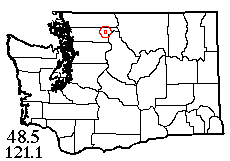 |
![]() 30 VIII 2012: I ordinarily wouldn't think of collecting so late in the summer, but the previous week's good results (and Matisse's availability) persuaded me to try one more mountain-hiking trip. I chose a project I thought couldn't miss: back in 1985 I'd been on a hike up the Hidden Lake Trail, just outside North Cascades National Park, and didn't realize the trail crossed a grid line. I got partial samples on both sides of the line, later completing the lower sample on a second trip, but still with only 16 species from my main site at the eastern point of the trail: 5 species to go! Today, in lovely partly-sunny weather, we arrived at the trailhead uneventfully, and started up a very well-maintained, but physically taxing trail climbing from 3700 to 5500' elevation, through forest at first, then in gorgeous treeline meadows with small groups of mountain hemlock, silver fir and slide alder. The trail stays on the right side of the grid line for a relatively short distance before crossing it again, and I kept thinking the habitat would be better around the next bend. It's a good thing I took a GPS reading before we really got started collecting! Back in the right area, we tried to concentrate on habitats I hadn't tried back in '85: conifer foliage (got us 7 species, 3 not taken before); conifer litter (could find no good litter in the very small tree groups we could access, and only got one species, taken on the earlier trip); and dead wood (could find very little and only got one species, already taken). Matisse kept spotting wolf spiders, including the one I'd already taken but also Trochosa pratensis, an extremely interesting record, not found before in the high western Cascades. Matisse got a Dictyna from heather but it was juvenile.
30 VIII 2012: I ordinarily wouldn't think of collecting so late in the summer, but the previous week's good results (and Matisse's availability) persuaded me to try one more mountain-hiking trip. I chose a project I thought couldn't miss: back in 1985 I'd been on a hike up the Hidden Lake Trail, just outside North Cascades National Park, and didn't realize the trail crossed a grid line. I got partial samples on both sides of the line, later completing the lower sample on a second trip, but still with only 16 species from my main site at the eastern point of the trail: 5 species to go! Today, in lovely partly-sunny weather, we arrived at the trailhead uneventfully, and started up a very well-maintained, but physically taxing trail climbing from 3700 to 5500' elevation, through forest at first, then in gorgeous treeline meadows with small groups of mountain hemlock, silver fir and slide alder. The trail stays on the right side of the grid line for a relatively short distance before crossing it again, and I kept thinking the habitat would be better around the next bend. It's a good thing I took a GPS reading before we really got started collecting! Back in the right area, we tried to concentrate on habitats I hadn't tried back in '85: conifer foliage (got us 7 species, 3 not taken before); conifer litter (could find no good litter in the very small tree groups we could access, and only got one species, taken on the earlier trip); and dead wood (could find very little and only got one species, already taken). Matisse kept spotting wolf spiders, including the one I'd already taken but also Trochosa pratensis, an extremely interesting record, not found before in the high western Cascades. Matisse got a Dictyna from heather but it was juvenile.
I'd estimated that leaving our site at 7 pm would get us to the car by dark. We left on time, and I swept my way down to the grid line, getting only a few spiders, but including another Dictyna – alas, also juvenile! The sun sank behind the mountains before we hit treeline, and we still had probably a half mile to go when the light became too dim to easily see our footing, much sooner than I'd expected. Fortunately, we both had flashlights and the trail was in such good shape that our little lights brought us to the car without significant trouble. If we'd waited another hour, the full moon (called a "blue moon" by the news media) was so bright we might have been able to finish the hike even without our flashlights. We were back in Seattle around 11:40, but of the 13 species found on site, only 4 were additions to the list, leaving me still one short, curses! Well, that trail is supposed to be beautiful in fall colors too…
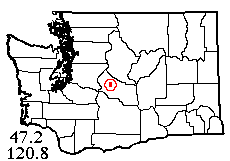 |
![]() 18 X 2012: In June of the previous year, I and Laurel Ramseyer had taken 8 species at a campground site near where the Teanaway River’s north, middle and west forks join. Today I returned to the site for fall spiders with new volunteer Lauren Taylor, driven over the mountains by somewhat ominous weather forecasts. Arrived at our destination, the day was sunny and pleasantly cool with just a few clouds. We parked near the old pine-cone collecting site and hiked through the campground to collect along the river, where the pines gave way to cottonwood trees displaying brilliant yellow fall colors, with a few red vine maples for variety. My main object was to sift leaf litter, and I found just one area with fairly productive cottonwood-plus-pine litter. It was very slow going and took me hours, but ultimately I sifted 15 species including a few rarities. A nearby squirrel kept posing for my camera. I had set Lauren to looking under rocks, but she hadn’t found any mature specimens, so eventually "the old pro" had a go and got three species near the bank of a deep section of the cold, very clear river. Other habitats: wood fragments, snowberry bushes and herbs/shrubs on a large gravel bar, each added a few species, and Lauren beat seven from fir foliage.
18 X 2012: In June of the previous year, I and Laurel Ramseyer had taken 8 species at a campground site near where the Teanaway River’s north, middle and west forks join. Today I returned to the site for fall spiders with new volunteer Lauren Taylor, driven over the mountains by somewhat ominous weather forecasts. Arrived at our destination, the day was sunny and pleasantly cool with just a few clouds. We parked near the old pine-cone collecting site and hiked through the campground to collect along the river, where the pines gave way to cottonwood trees displaying brilliant yellow fall colors, with a few red vine maples for variety. My main object was to sift leaf litter, and I found just one area with fairly productive cottonwood-plus-pine litter. It was very slow going and took me hours, but ultimately I sifted 15 species including a few rarities. A nearby squirrel kept posing for my camera. I had set Lauren to looking under rocks, but she hadn’t found any mature specimens, so eventually "the old pro" had a go and got three species near the bank of a deep section of the cold, very clear river. Other habitats: wood fragments, snowberry bushes and herbs/shrubs on a large gravel bar, each added a few species, and Lauren beat seven from fir foliage.
We had some daylight left and seemed to have exhausted the new habitats at our site, so we slowly drove back down the road and stopped near a scenic bridge across the North Fork where there were fairly extensive grassy fields, and I taught Lauren how to sweep. The sweeping was fairly good (8 species in all), amid new views of fall colors and mountains. Cows across the road seemed entertained by our activity, little suspecting we were about to eat beef! In all we got 27-28 species making 33-34 with last year’s records. On the way home I introduced Lauren to Mountain High Hamburgers and she agreed that a Mt. Adams Burger with shake was richly satisfying after a day in the field.
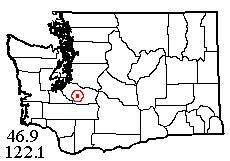 |
![]() 16 XI 2012: The rains had set in with a vengeance, but we had a very brief dry weather window in mid-month, predicted to end on Friday. I had long wanted to make the relatively short trip to Electron, central Pierce County (site of one of our earliest hydroelectric power stations, still operating) to supplement an old 10-species sample. Lauren and I left Seattle on time, but on our way south we had some misgivings when a few splashes of rain spattered the windshield. As we passed through Orting, it was clear that a morning cloudburst had preceded us, but miraculously the roadway dried up somewhat as we approached our destination, the power station turnoff. Finally arrived at Electron Park, we found that the historic hydro station couldn’t really be seen and practically all habitat was on the wrong side of a fence from the park! After extracting one spider from the outhouse, we headed back down the road and settled at a roadside turnout (pretty moist) where there were enough fir and hemlock trees (without too much water on the needles) to make beating possible. The maple leaves had fallen, so fall colors were less scenic than on our last trip.
16 XI 2012: The rains had set in with a vengeance, but we had a very brief dry weather window in mid-month, predicted to end on Friday. I had long wanted to make the relatively short trip to Electron, central Pierce County (site of one of our earliest hydroelectric power stations, still operating) to supplement an old 10-species sample. Lauren and I left Seattle on time, but on our way south we had some misgivings when a few splashes of rain spattered the windshield. As we passed through Orting, it was clear that a morning cloudburst had preceded us, but miraculously the roadway dried up somewhat as we approached our destination, the power station turnoff. Finally arrived at Electron Park, we found that the historic hydro station couldn’t really be seen and practically all habitat was on the wrong side of a fence from the park! After extracting one spider from the outhouse, we headed back down the road and settled at a roadside turnout (pretty moist) where there were enough fir and hemlock trees (without too much water on the needles) to make beating possible. The maple leaves had fallen, so fall colors were less scenic than on our last trip.
Both of us beat tree foliage for 40 minutes or so, ending up with 11 spider species that all by themselves brought the area up to 21 species. The ground was too wet for the sifting cloth, so I had Lauren park pointing uphill and sifted on her car’s hood. It worked well, and I got 14 species from moss on the maples plus eleven from leaf litter (the only good litter we found, in crotches of a giant stump; litter on the ground was soaked and entwined with blackberry vines). While I finished up the sifting, Lauren beat some understory ferns, and even this produced 9 species. Now the rain we’d managed to dodge so far seemed about to catch up with us, plus Lauren was cold, so we called it a day – having taken 32 species in three and a half hours, all in the public right-of-way within 20 feet of Electron Road. And not one duplicated the 10 previous records, so I now have over 40 from there!
18 field days, mostly thanks to Joy, Matisse and Lauren, completed 2012. Stay tuned for 2013!
This page last updated 21 March, 2025